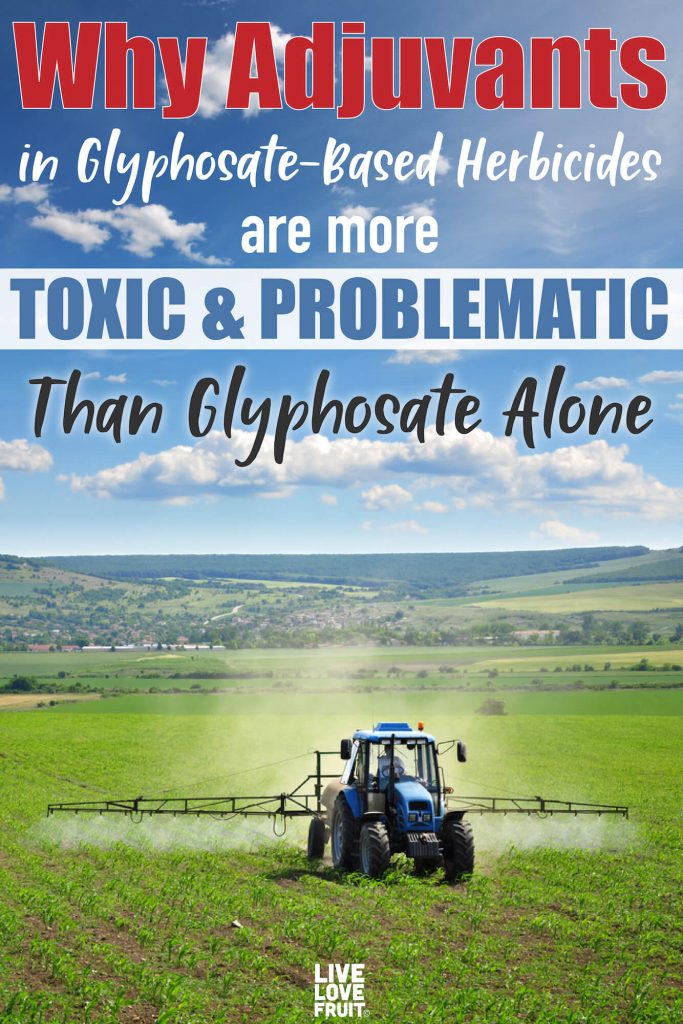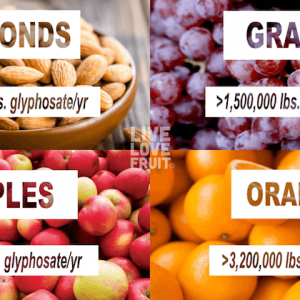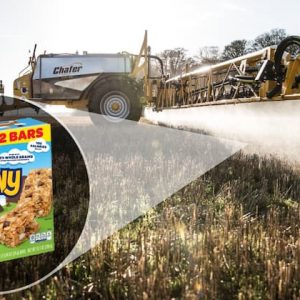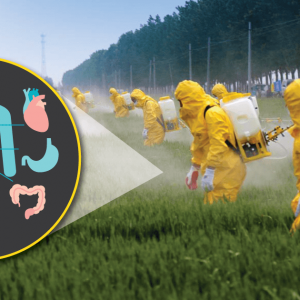
Ever since studies started coming out pointing to the dangers of glyphosate and its connection to cancer, everyone has been trying to avoid it. But not many people have questioned the other ingredients, like adjuvants, present in glyphosate-based herbicides.
It is curious as to why adjuvants in glyphosate-based herbicides haven’t been given an even bigger spotlight than the one glyphosate has been given. After all, many studies have declared that the adjuvants used along with the active ingredient, glyphosate, are even more problematic, and toxic than glyphosate (and by quite significant amounts).
What Is an Adjuvant?
An adjuvant is any substance in a herbicide formulation added to improve herbicidal activity or “application characteristics” (1).
There are two types of adjuvants: activator adjuvants and special purpose adjuvants.
Activator adjuvants are often used to enhance post emergence herbicide performance, and can increase herbicide activity (like enhanced absorption into plant tissue and rain-fastness). Activator adjuvants often include surfactants, crop oil concentrates, nitrogen fertilizers, spreader-stickers, wetting agents and penetrants.
Special purpose adjuvants may alter the physical characteristics of a spray solution and widen the range of conditions under which a herbicide formulation is useful. This type of adjuvant includes compatibility agents, buffering agents, antifoam agents, and drift control agents.
Manufacturers have been adding toxic adjuvants into glyphosate for the last 25 years and no one has been talking about them. In a sense, the pesticide industry has been deceiving the public by referring only to glyphosate, and not to the adjuvants.
Why Adjuvants in Glyphosate-Based Herbicides Are Problematic
So why are the adjuvants in glyphosate-based herbicides a problem? After all, glyphosate is the active compound, so it must come with the greatest risk, right? Wrong.
Gilles-Eric Séralini, French scientist who examined adjuvants used in Roundup formulations made it clear that “There are several hidden toxic compounds in Roundup that are far, far more toxic than glyphosate, but they have not been tested in long-term studies like glyphosate — that means for two years with a rat” (3).
The paper, published in Toxicology Magazine, compared the toxicology and composition of nine Roundup formulations using different human cell lines. The study showed how glyphosate-based herbicides pose an environmental and occupational risk for humans, like farmers or others who spray the products.
While active ingredients in pesticides and herbicides (like glyphosate) are the most common ingredients studied to test toxicity levels, it is the adjuvants that are often left out. According to Séralini, this is problematic since adjuvants enhance a pesticide/herbicides stability and penetration into cells (thus making them more harmful than active ingredients alone), yet they’re still classified as “inert” (aka. chemically inactive).
In his study, Séralini tested the differential and combined cytotoxicity of the major pesticides in the world (like glyphosate-based herbicides) and analyzed their composition and mechanisms of action. These products included Roundup Ultra, Roundup GT, Roundup GT+, Roundup Bioforce, Roundup 3plus, Glyphogan, Topglypho 360, Clinic E.V., and Bayer GC. For controls, they tested formulations containing POE-15 without glyphosate and POE-15 alone (POE-15 is a major adjuvant).
Human cell lines tested were HEK293, JEG3 and HepG2 cell lines – three models where unexpected effects of glyphosate-based herbicides had already been demonstrated. The researchers also demonstrated that these cell lines were even less sensitive than primary cells, and were therefore more representative of real cellular toxicity.
They discovered that all formulations were more toxic than glyphosate alone on all human cell lines. They also experimentally separated three groups of formulations differentially toxic according to the amount of ethoxylated adjuvants. The 3 less toxic formulations (like glyphosate alone) were found to contain no ethoxylated adjuvants by mass spectrometry, and were 10,000 times less toxic on mitochondrial activity than POE-15 alone (a major adjuvant). All other formulations were toxic proportionally to the dilutions of POE-15 or other ethoxylated adjuvants in the formulations, in a linear manner.
At just 1 and 3 parts per million (ppm), POE-15 started displaying negative effects on cellular respiration and membrane integrity. This membrane disruption then led to the necrotic adjuvant-linked effects observed, amplifying the necrosis/apoptosis (cell death) ratio by contrast to glyphosate at higher levels.
Séralini and his team made note that while it should not be forgotten that glyphosate has its own toxicity, the harmful effects of adjuvants alone might be something we should perhaps even be more concerned about. They also mention that their study only took place during a 24-hour time frame, and therefore it does not accurately represent how an adjuvant might behave over long periods of time, and the bioaccumulation effects that follow.
“I don’t think that agricultural workers understand that glyphosate is not Roundup,” said Séralini at the annual Canadian Organic Conference. “Roundup is 100,000 times more toxic on human cells than glyphosate, and glyphosate is just 15 percent of what’s in Roundup…There’s a vast underestimation of its effects” (4).
Other studies have also demonstrated the toxicity of Roundup versus glyphosate alone. Researchers at France’s Université de Caen investigated the effects of the full Roundup formulation and glyphosate alone on cultured human placental cells (5). They found that the herbicide killed the cells at concentrations far below those used in agricultural practice. They also found that Roundup was at least twice as toxic as glyphosate alone.
Because most studies performed on Roundup for long-term health damage has been done on the active ingredient, glyphosate, rather than on the full herbicide formulation, we might not be getting the full story. Glyphosate only makes up about 40% of Roundup formulations – so why are we ignoring the other 60%?
The researchers from this study found that a 2.0% concentration of Roundup and an equivalent concentration of glyphosate killed 90% of the cultured cells after 18 hours’ incubation. The median lethal dose for Roundup (0.7%) was nearly half that for glyphosate, meaning Roundup was twice as toxic as the single chemical alone.
The authors of the study concluded that the demonstrated toxicity of Roundup, even at concentrations below those in agricultural use, could contribute to reproduction problems.
Adjuvants and Their Effect on the Environment
Adjuvants are also toxic for frogs and amphibians, due to their penetrable effects.
“It is well documented that formulations of glyphosate, whether its Roundup or Touchdown or any other generic…are extremely toxic to amphibians. That is due to that surfactant. The amphibians have a very wet skin that absorb things very easily,” said Bob Hartzler, an Iowa State University weed science professor (6).
Due to the lack of long-term monitoring data on the fate of adjuvants, not many studies have looked into how they affect the flora and fauna. Unlike herbicide labels, most adjuvant labels or MSDSs do not include information of the compound’s behavior or fates in the environment (in plants and soil). The adjuvant’s mechanism of action, rates of metabolism within plants, rates of photo-degradation or microbial degradation, persistence (half-life) in the environment, potential for volatilization, or potential mobility in soil or water is also not disclosed (7).
What is known, however, is that many surfactants do adsorb to soil particles, meaning that they are less toxic to plants in soil than to plants growing in water or other aqueous solutions (and hence why they are also more toxic to amphibians).
For the sake of the environment and the safety of our own health, more studies need to be performed on adjuvants to make the public aware that it isn’t just glyphosate alone that is the problem.









Leave a Reply